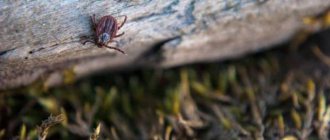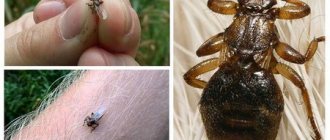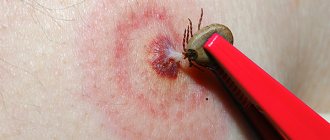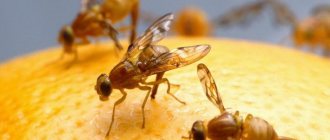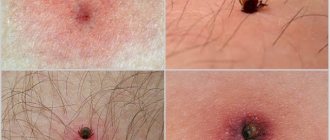The classic woodlice looks like a slightly flattened small bug with a body length of 10 to 15 mm, although larger specimens are also found. It has two pairs of antennae and is covered with a shell. The color of woodlice, as a rule, resembles modern metallic or gray with an admixture of brown. This inconspicuous appearance makes it easy to remain invisible on the surface of the earth or under a stone. Only in certain species are there stripes or barely noticeable patterns on the shell.
Many consider woodlice to be very unpleasant creatures that cause disgust and are extremely disgusted with them. This is understandable, since their appearance does not excite others at all. And if we add to this the fact that wood lice are considered pests, then there is every reason to be wary of them.
It is curious that the woodlice is not an insect , but a crustacean creature from the order of isopods. The first and direct evidence of this can be the gills, which are modified in some way compared to fish and arthropods, but, nevertheless, they help woodlice to breathe. Woodlice also have much more legs than insects. The nature and behavior of wood lice conceal a lot of interesting things. This will be discussed in our review.
Duration and lifestyle
Woodlice prefer to lead a lifestyle that directly follows from their name. Only we are not talking about direct stay in the aquatic environment, as higher crayfish prefer to do, but in a slightly different way. Basically, they lead a terrestrial lifestyle , but certainly in places where it is warm and humid .
Many people have discovered these crustaceans while collecting mushrooms under the forest floor, as well as under stones and objects lying around their summer cottage, as well as simply in the ground or under the bark of damp wood. These organisms thrive in habitats such as the coasts of small swamps and lakes. Interestingly, during the daytime, woodlice are usually passive and hide, as they are considered nocturnal animals. It is in the dark that they go hunting.
In case of danger, woodlice prefer to curl up to resemble a ball as much as possible. They live quite a long time for such organisms; in some species there are individuals up to two years old, but this is under favorable circumstances. And on average, the life expectancy of woodlice does not exceed 12 months .
They cannot exist without a source of water, since the gills must constantly be in a moist environment. Otherwise, these animals will suffocate due to respiratory arrest. If environmental conditions become unfavorable, woodlice can immediately change their lifestyle and go into suspended animation. However, there are species that are perfectly adapted to life in dry conditions. For example, some of them feel great in the North African deserts, buried a full meter deep where it is quite cool and there is moisture. They come to the surface only at night in search of food. Some species of woodlice live in seawater, in shallow waters, and are greenish in color.
Once in a dry and very warm place, woodlice will behave extremely anxiously. They begin to quickly move and spin, as if trying to get into a more comfortable zone in any way. In order not to dry out, these creatures can begin to mutually tighten each other along the length. As a result, their shell sticks together and their body length decreases. Accordingly, the surface area from which moisture loss occurs is significantly reduced. In more familiar conditions, wood lice, as a rule, move extremely slowly, or are generally static.
Woodlice diet: simplicity and minimum calories
The vast majority of woodlice feed on plant foods. However, it is also worth mentioning large deep-sea decapod crayfish: they, strictly speaking, do not even belong to woodlice, but are very similar to them and are often called giant woodlice. These creatures also eat mainly algae, benthos, and the remains of various dead animals, but they can also eat live sea cucumbers, sea anemones, and other soft-bodied marine life that are unable to move.
Most woodlice are typical processors of dying and rotting plants. In forests, fields, plantings and even deserts, they feed on parts of withering plants, their roots, rotting fruits, seeds and falling leaves. Considering that there is a lot of such organic matter in nature, woodlice, as a rule, do not have problems finding food.
Most often, woodlice find food under stones, under old snags or under fallen leaves. Here, away from the sun's rays, plant material is accessible and rots more easily, and the crustaceans themselves are safe and less accessible to predators.
On a note
The digestive tract of woodlice contains bacteria that can digest cellulose fibers. They are not as versatile as the symbiont bacteria of termites, but still ensure the normal absorption of fairly coarse plant parts.
Generally speaking, in terms of their diet, woodlice are real minimalists. Their food is quite low in calories and contains very little fat.
It is also useful to read: Details about woodlice: interesting facts about their life and photographs
As a rule, woodlice feed, causing virtually no harm to living plants and are usually content with what falls and begins to rot (however, there are exceptions when these picky eating creatures still damage the living parts of garden plants, causing them harm).
Thanks to this way of feeding, woodlice turn out to be very useful organisms for biocenoses, processing and utilizing large quantities of rotting plant residues.
What do woodlice eat?
The diet of woodlice is quite varied. Their food is mainly vegetarian; they especially like anything that has already rotted - these can be leaves , roots , plant seeds , mold . They are also attracted to lichens , algae and bacteria , which live in huge quantities in humid environments. Once in a person’s home or in outbuildings, such as cellars, wood lice always find themselves one hundred percent provided with high-quality food. In such places there will always be enough remains of organic matter and mold for a full existence.
Habitat of woodlice in wildlife
Many people have spotted this insect on old wet stumps, under forest snags - these are bugs that live in damp places.
Damp corner in the apartment
This is why they got their name - they live in a wet place. Favorite places:
- pits;
- lowlands;
- swamps;
- dampness;
- old snags and stumps;
- tree hollows.
Even if it rains heavily, the gills will allow the woodlice to survive and also reproduce in such inhospitable conditions.
How many legs does a woodlice have?
An adult woodlice has 7 pairs of legs , and a larva has 6 pairs .
You can examine the woodlice in detail only by taking a photo using macro photography. Then it becomes clear that it really is very similar to crustaceans. Not only is it covered with chitinous scutes, which is not observed in insects, but it also has seven pairs !
Peculiarities of reproduction and distribution of woodlice
Woodlice can be considered very unique organisms in terms of sexuality, since they can produce offspring in two ways. We are talking about direct copulation and the method of parthenogenesis .
Their mating usually occurs in the spring. In this case, the seed falls into a pair of special holes located on the female’s body, or rather in the fifth segment of her body. These holes communicate with seed receptacles, which subsequently spontaneously collapse and then the seed enters a chamber called the oviduct. When the first phase of “pregnancy” ends, the woodlice begins to molt and radically changes its body shape. Thus, it adapts for subsequent bearing and birth of offspring. The previously mentioned paired genital openings of the woodlice are transformed into a single one. It is through it that already fertilized eggs are released. The brood chamber is formed by small plates that form on the front legs. It is inside that her eggs “live” for a month and a half until they mature. After which the female will be released into the world to live independently. The partially unused seed remains inside the woodlice and is, as it were, temporarily preserved to serve as a means for fertilizing the next generation.
Separately, it is worth noting that male woodlice are very patient and persistent, since the sexual intercourse itself is very long. They look for a partner in advance, take the position necessary for copulation and wait for a long time until she throws off her old shell and opens the seminal receptacles.
Is it possible to poison them?
Living in the same area with woodlice is very unpleasant, to say the least. There are various ways to combat these crustaceans. Usually folk or chemical remedies are used. If unpleasant guests appear in the apartment, this indicates increased humidity in the room (we tell you more about why woodlice appear in apartments and how to get rid of them here).
One of the easiest ways to get rid of woodlice is to dry the entire house and get rid of moisture. But sometimes this is not enough. It is then that you will have to use proven methods that will help get rid of the misfortune. Woodlice do not tolerate alkalis and acids, dryness and high temperatures.
It is recommended to use the following chemicals and products on your own at home:
- Insecticidal aerosols . Sold in cans (for example, Combat, Varan, Raptor, Dichlorvos). It is best to use such products in small rooms. Since the cans are not enough for a large space.
- Pesticides soluble in water (Taran, Tetrix, Get, etc.). These are the products that are used in professional pest control. They allow you to destroy pests at low cost over a vast area.
- Preparations in powder form (Clean House, Riapan, Neopin, Phenaxin). They are used as follows: they are scattered on the floor of the place where woodlice live and wait. However, they have a disadvantage. It consists in the fact that they are not effective against insects that crawl along the walls. Therefore, they can only be used in a cumulative war, together with other drugs.
- Insecticidal pencils or crayons . Pencils are convenient for use on walls. It is very effective to use chalk as a barrier. When the woodlouse crosses the chalk line, it will die.
- Gels (Absolut, Fasgel, Cleanbeit). Excellent preparations, their effectiveness can be compared with crayons.
There are also traditional methods of killing insects. The following methods are quite widely used:
- You need to mix boric acid and water. You need to take 10 grams of acid per 500 ml of water.
- You can mix hot pepper, soda and tobacco in equal quantities (take 3 g of each ingredient per liter of boiling water).
- One hundred grams of dry kvass is diluted in 500 ml of liquid.
A very effective way to combat pests is exposure to hot steam. They cannot tolerate this and therefore die immediately.
More information about the reasons for the appearance of woodlice in houses and apartments, as well as about effective ways to combat them, can be found in a separate article.
Woodlice larvae
The woodlice larva has an appearance that somewhat distinguishes it from adult crustaceans. First of all, she has only 6 pairs of legs , the seventh appears later. And the most important distinguishing feature of the larva is its color. After all, before becoming a full-fledged individual, she has to endure up to 10 molts .
It is not surprising that for this reason the larvae look mostly “transparent”. This continues for three months. By the way, it is customary for woodlice to look after younger individuals. They protect the young in case of approaching danger and help them reach food sources.
The benefits and harms of woodlice
You can talk about the benefits and harms of woodlice for a long time, since it all depends on the environment in which they live.
If we are talking about an outdoor garden, then we can assume that wood lice help humans in some way. Making endless movements across the surface and in the depths of the earth, they destroy dead, rotting organic matter and in a unique way heal the soil, saturating it with organic fertilizers. Woodlice can feed on various pathogenic microbes living on plants, and this relieves them of many diseases. On the other hand, if the colony is too large, then the appetite can go off scale to such an extent that living roots, thin stems and leaves of plants will be eaten. These organisms are especially dangerous in humid and comfortable greenhouses, as they can easily destroy large volumes of vegetable seedlings.
In an apartment, woodlice are happy to attack indoor flowers, especially if they have delicate and thin leaves. They do not disdain vegetables; they like to leave behind holes on leaves and flowers.
For the cellar, wood lice are the worst enemy, since during the winter they can have a good time with the harvest stored in the open.
Preventive measures at home
To prevent woodlice from appearing again, it is enough to recreate conditions that are unsuitable for their life: dry the room and ventilate it as often as possible, eliminate the source of moisture (leaks). It is necessary to take out the garbage as it is full, especially if there are rotting remains of fruits or vegetables.
You should not accumulate mountains of unnecessary rubbish and create secluded places for woodlice to live. Check the condition of ventilation, install a protective mesh . If you treated the room with an insecticide or folk remedies, it is better to repeat the treatment after 10-14 days. The adults die the first time, but the larvae can survive.
Attention! It is important to maintain cleanliness in the garden, promptly get rid of fallen leaves, stones, branches, not to over-moisten the soil and ventilate and dry greenhouses.
Although woodlice do not pose a particular danger to humans, being around them does not bring any pleasure. They, contrary to popular belief, are not insects, but are land crustaceans. To prevent woodlice from appearing at home, it is enough to maintain a normal level of humidity, ventilate the room and keep it clean.
Can a wood louse bite?
The question is quite natural: do woodlice bite? Could they pose a direct threat to people? We hasten to reassure everyone that this is impossible !
Firstly, although these creatures are small crayfish, they are not predatory. Secondly, it was stated earlier that they love to enjoy eating soft, rotting food of organic origin. Accordingly, their oral organ in no way has the ability to bite through anything harder than the thin root of a plant. Therefore, there is absolutely no need to be afraid of wood lice for this reason.
Is woodlice dangerous for humans?
First of all, woodlice in the house is unsanitary! And although they are not generally considered dangerous, nevertheless, traveling over quite significant distances, they are capable of transmitting infectious diseases. Although to a lesser extent than the well-known cockroaches. In general, woodlice cannot be considered social pests, since they generally prefer a hidden lifestyle and stay away from human eyes. But, you must admit that few people will be pleased to find an unsightly-looking animal on the dining table or dishes, which a little earlier was crawling quite calmly on the floor in the toilet, in the cellar, or simply in the ground. The appearance of even individual individuals should serve as a signal that there is a source of excess uncontrolled moisture in the house, which woodlice love so much. Therefore, it’s time to start finding and eliminating it. There will be no leaks in the sewer system, no rotten garbage, no dampness in the bathroom, the normal functioning of ventilation will resume - wood lice will disappear without outside help.
It is curious that among woodlice there are none that in any way produce substances that are toxic to humans. And according to the conclusions of people who wanted to taste them, it follows that crayfish and shrimp are much more appetizing, since everything is spoiled by the rather pungent taste of urea.
Characteristics of crustaceans
Several species of crustaceans live in temperate climates. You can find a description and classification of woodlice here, and read about white woodlice in this material.
Common armadillo
The common armadillo (Armadillidium vulgare) is a very famous and common species of woodlice. The land species, the order of isopods, has been well studied.
It has an oblong dense body, divided into segments and seven pairs of legs. A head with a pair of eyes on the sides and four antennae. Two antennae are long, the other two are shorter. Reach a length of 10-12 mm . The color gray is sometimes closer to black, but there are also very light ones.
Woodlice are generally not dangerous to humans and their homes (read about the dangers and methods of controlling woodlice here). They do more harm to vegetation because they eat it. It is believed that these crustaceans can carry viruses and bacteria, but this has not been proven.
Centipede
The second name is flycatcher. Does not apply to insects. It is an arthropod from the family of centipedes, a subphylum of tracheae. Found in dark, moisture-saturated places .
The flycatcher has a flat body. It is divided into segments, there are 15 of them. Each segment has a pair of legs. The front pair are jaws and are used for catching prey. In most cases the body color is gray with red, brown or pink. But there are also yellow ones.
Centipedes do not damage furniture, wallpaper, and do not transmit various diseases and viruses. The centipede is predominantly nocturnal. It feeds on flies and cockroaches.
When there is a threat to its own life, it can bite. The sting is not fatal, but unpleasant, almost like a bee sting. It is better to avoid such situations, since if you are allergic to insect venom, the bite can cause swelling and a negative reaction.
After a bite, if weakness, dizziness, breathing problems and other reactions occur, you should urgently call an ambulance or consult a doctor.
We invite you to watch a useful video about centipedes:
Silverfish
Scientific name: Lepisma saccharina. Small insect, bristletail order. Lives in residential premises and food warehouses . Presumably one of the oldest insects still living today.
The silverfish has an oblong body, 0.8 to 1.9 cm long, with a large number of legs for rapid movement. When reaching puberty, the individual is completely covered with small scales. Eats small insects and ticks harmful to humans.
Silverfish does not pose a threat to human life and health and does not carry infections. Unpleasant only for its appearance. But thanks to its gastronomic preferences in food, it can cause harm, since it feeds on foods that contain starch and polysaccharides. The food goes to:
- books;
- glue;
- sugar;
- flour;
- potato;
- wallpaper;
- photos.
We invite you to watch a useful video about silverfish:
Double-tailed
An arthropod with a small body size, belonging to the order of cryptomaxillary six-legged insects.
The insect is 5 mm long, some species reach 50 mm. The two-tailed fish has no eyes ; it uses long antennae, which are very sensitive, to navigate in space. At the back there is a cercus - a growth in the form of claws or forceps, which is used as protection and for holding prey. If necessary, the two-tailed fish can get rid of them, but then the claws grow back. It has a red-brown color.
Is double-tailed dangerous? This question comes up often. Insects damage indoor plants, vegetables, fruits and berries in the garden. When two-tailed insects appear in the house, there is a risk of being bitten and infected. The bite is very painful; large two-tailed ones can easily damage the skin and leave a mark in the form of two wounds. The sores may be very itchy, red and swollen.
If an allergy occurs, blisters with fluid may occur. If they are opened, ulcers appear in their place, which cause pain, discomfort and do not heal for a long time.
Two-tailed fish are not poisonous, but their bite requires treatment with disinfectants and antibacterial substances. If an allergic reaction occurs, immediately call an ambulance or consult a doctor.
Transparent
Transparent (white) wood lice are the same silverfish . This is what they become after they have shed three times. Respiration is carried out using gills. They reproduce quite quickly. Clutches of one hundred eggs, from which an independent insect emerges almost a month later.
It leads the same lifestyle, eats and causes harm in the same way as the silverfish. Safe for humans.
